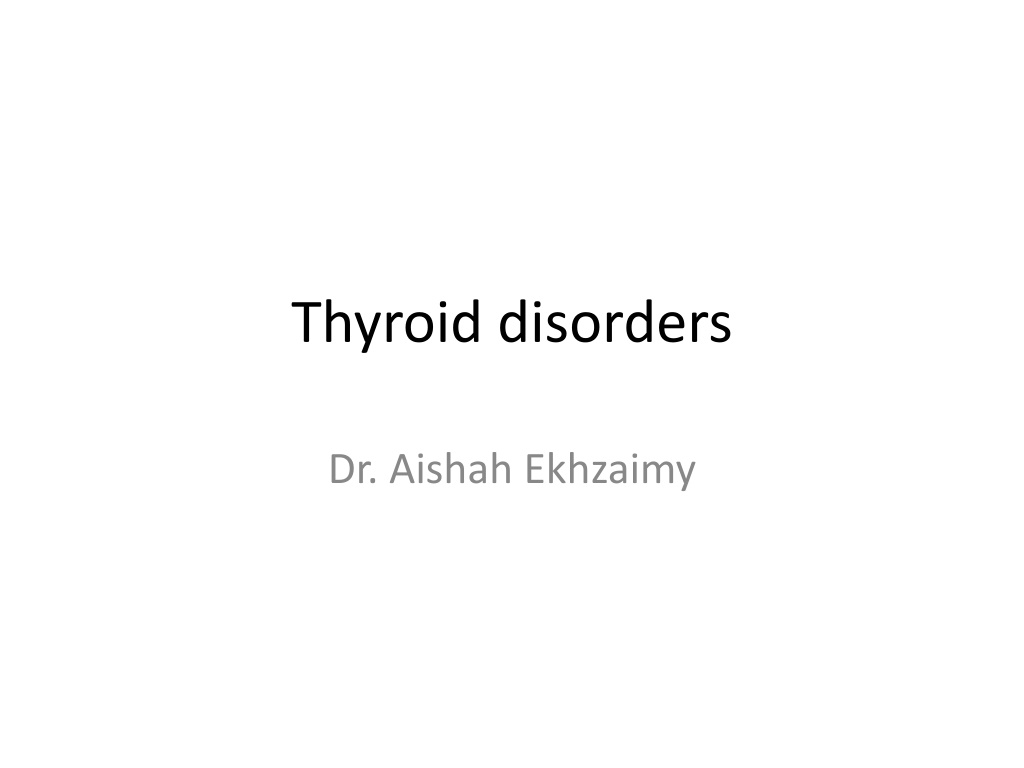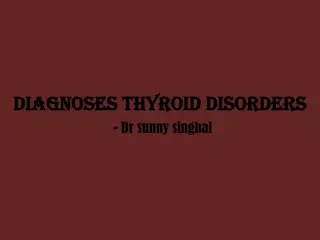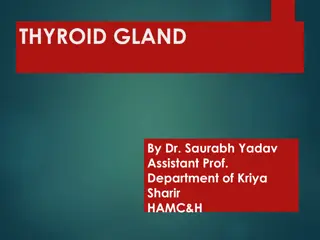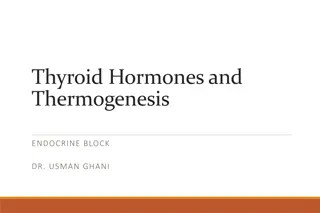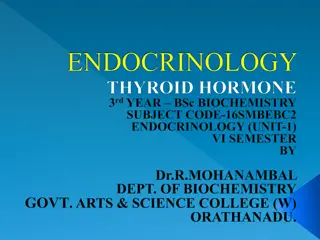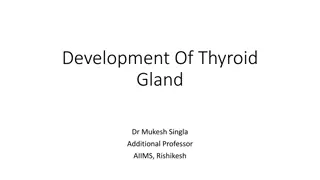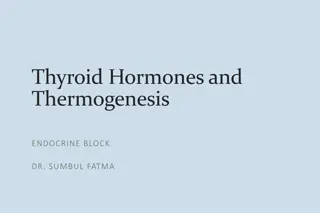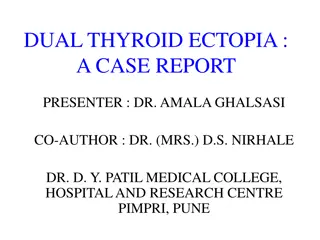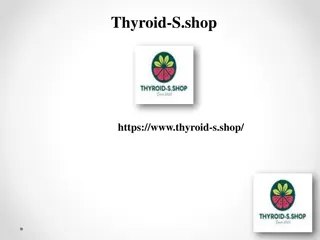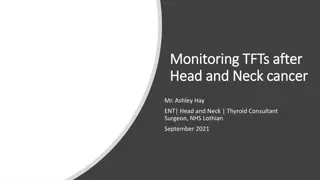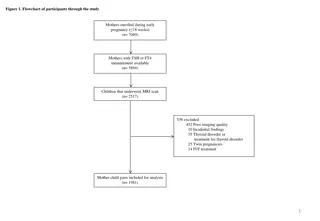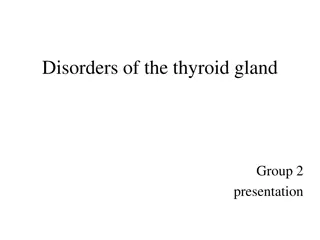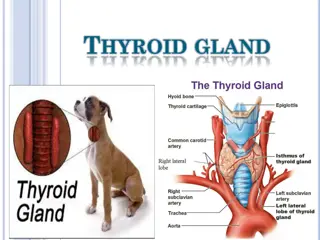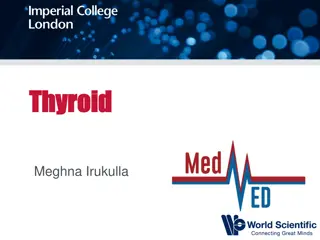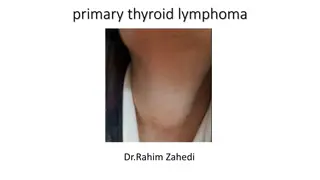Comprehensive Guide to Thyroid Disorders and Hormones
Delve into the anatomy, physiology, and disorders of the thyroid gland, including goiter, hyperthyroidism, and hypothyroidism. Explore the role of thyroid hormones in somatic and brain development, as well as fetal functions. Understand the synthesis, storage, and action of thyroid hormones, along with the impact of iodine intake. Discover crucial information on thyroid hormone regulation and its effects on the body.
Download Presentation

Please find below an Image/Link to download the presentation.
The content on the website is provided AS IS for your information and personal use only. It may not be sold, licensed, or shared on other websites without obtaining consent from the author.If you encounter any issues during the download, it is possible that the publisher has removed the file from their server.
You are allowed to download the files provided on this website for personal or commercial use, subject to the condition that they are used lawfully. All files are the property of their respective owners.
The content on the website is provided AS IS for your information and personal use only. It may not be sold, licensed, or shared on other websites without obtaining consent from the author.
E N D
Presentation Transcript
Thyroid disorders Dr. Aishah Ekhzaimy
Objectives Thyroid anatomy and physiology Action of thyroid hormones Thyroid function Thyroid disorders: Goiter Hyperthyroidism Hypothyroidism
Thyroid gland Thyroid gland is made up of follicles Has 2 lobes and connected by the isthmus Weigh 20 g, more volume in men, increase with age and bodyweight and decrease with iodine intake Located infront of larynx
Thyroid hormone Somatic development in adults Brain development in infants Fetal thyroid functions at 10-12 weeks of gestaion Maternal T4 reaches the fetus during development if mother has hypothyroidism------------ preterm delivery, miscarriage, cognitive impairment of infant Main action of thyroid hormones by T3 : 80 % from peripheral conversion and 20 % produced by the thyroid itself
Thyroid hormones Follicular cells of the thyroid is the main site of hormones synthesis Mainly T4 and small amount of T3 Iodine is needed to produce thyroid hormones Average adult requirement of iodine is 150 mcg a day, 220 mcg for pregnants, 290 mcg for lactating Source of iodine: dairy and seafood products
Thyroid hormones Stored in the thyroglobulin in follicular cells of the thyroid gland 99.9 % of T4 and T3 are bound to protein in the blood: TBG, albumin, lipoprotein T4 and T3 synthesis and secretion is regulated by pituitary TSH. TSH is inhibited by T4 and T3, stimulated by TRH Extrathyroidal conversion of T4 to T3 is regulated by nutrition, illness, hormonal factors
Thyroid hormone action Thyroid hormones act on the bone and bone development In children: delayed growth and epiphyseal growth In brain: cognitive impairment Act on cardiac muscle: tachy and bradycardia Regulate metabolic rate and little change in bodyweight
Thyroid function TSH Free T4, FreeT3 TRH TBG Thyroid antibodies: microsomal antibodies, TSH receptor antibodies, thyroglobulin antibodies
Radiological imaging of thyroid function US neck Radioactive uptake scan CT neck sometimes for retrosternal goiter
Common thyroid disorders Goiter: chronic enlargement of thyroid gland not due to neoplasm Endemic Goiter: common in china and central africa Sporadic Goiter: multinodular goiter Familial
Goiter Hashimoto s thyroiditis: in early stage Graves disease: due to chronic stimulation of TSH receptor Diet: cabbage, Caulifower Chronic iodine excess Medication: lithium in 6% neoplasm
Goiter Assess thyroid function by : Free T4, FT3 TSH Ultrasound neck
Goiter-non Toxic Thyroxine suprression therapy: not useful Surgery: If pressure symptoms Malignancy Lymphadenopathy Radioactive iodine therapy
Hyperthyroidism Hypermetabolic state caused by increased availability of thyroid hormones
Clinical features of hyperthyroidism Skin: warm, excessive sweating Onycholysis, hyperpigmentation Pruritus, vitiligo, alopecia, thining of the hair Pretibial myoxedema
Hyperthyroidism Eyes: sympathetic overactivity Common in graves disease Extraocular muscles dysfunction: diplobia, proptosis, lid retraxtion,corneal ulceration, optic neuropathy and blindness Periorbital and conjunctival odema
Hyperthyroidism Cardiac: Atrial fibrillation in 10-20 % High output cardiac failure Wide pulse pressure, hypertension Respiratory: Dyspnoea GI: Weight loss, diarrhoea, increase liver enzyme
Hyperthyroid Bone: Bone turnover increased: osteoporosis Neuropsychiatry: Behavioral and personality changes: irritability, depression Hyperactivity increased
Lab-hyperthyroidism Increased Free T4 Increased Free T3 Low TSH TSH-receptor antibodies Increased radioactive iodine uptake on scan
Hypothyroid Causes Clinical features management
Hypothyroid-Diagnosis High TSH Low Free T4 and T3 Positive TPO antiboidies Low Na Anemia High cholestrol
Hypothyroidism- treatment Thyroxine replacement
